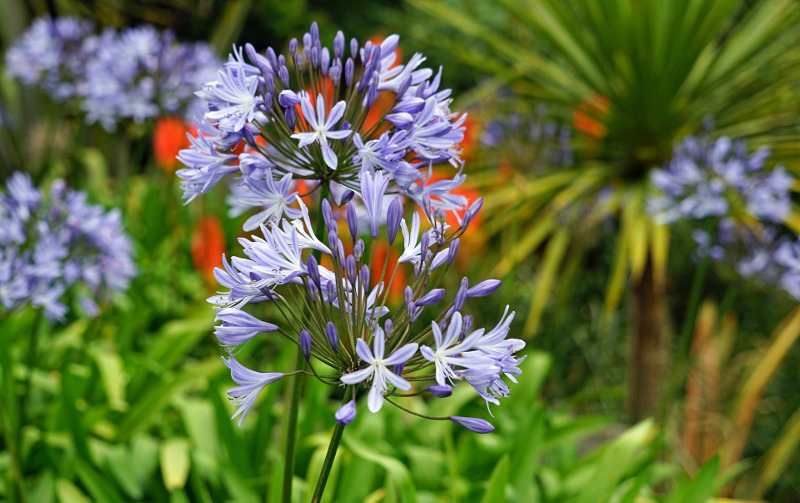Just how to Plant and Maintain Agapanthus in Your Garden
Just how to Plant and Maintain Agapanthus in Your Garden
Blog Article
Grasping the Art of Agapanthus Treatment: Vital Steps for Healthy And Balanced Development and Lively Blossoms
In the realm of gardening, the cultivation of agapanthus stands as a gratifying endeavor for those who seek to support these elegant blooming plants. From choosing the best variety to mastering pruning strategies, the trip towards cultivating growing agapanthus plants is multifaceted and holds the crucial to unlocking the complete possibility of these organic treasures.

Selecting the Right Agapanthus Selection

When choosing the best Agapanthus range for your garden, consider factors such as environment viability, flower color, and growth behavior. In addition, take into consideration the environment in your region to make certain the Agapanthus range you pick can grow in your details conditions. Comprehending the growth routine of different Agapanthus ranges is important for correct positioning within your garden.
Perfect Planting Problems
Thinking about the ideal environmental needs is important for successful Agapanthus growing. Agapanthus prospers in well-draining soil with a somewhat acidic to neutral pH level. When growing, select a location that gets complete sunlight to partial color. In hotter climates, providing some mid-day shade can prevent scorching of the fallen leaves. Agapanthus plants are sensitive to cool temperatures and should be secured from frost during winter season.
To make sure healthy and balanced development and lively flowers, plant Agapanthus light bulbs at a deepness of about 2-4 inches and space them 8-12 inches apart. Including raw material, such as garden compost, to the dirt can boost water drainage and fertility, promoting robust root advancement. Mulching around the base of the plants helps maintain wetness and subdues weed growth. Normal watering is critical, specifically throughout the growing period, to keep the dirt continually damp but not waterlogged.
Watering and Feeding Tips
Maintaining correct wetness degrees and offering crucial nutrients are key elements in the care routine for Agapanthus plants. When it involves watering Agapanthus, it is vital to strike a balance. These plants like regularly moist dirt however are vulnerable to root rot if overwatered. Throughout the growing season, water deeply when a week, guaranteeing the dirt is well-draining to stop waterlogging. In hotter climates or throughout periods of drought, even more regular watering may be required to maintain the dirt uniformly wet. However, decrease watering in the wintertime to protect against water logged conditions.
Fertilizing Agapanthus is necessary for promoting healthy and balanced development and prolific blossoms. Apply a well balanced plant food, such as a 10-10-10 formula, in the early springtime as new growth arises. By complying with these watering and feeding suggestions, you can guarantee your Agapanthus plants thrive and generate lively, durable flowers.
Trimming Techniques for Agapanthus
Pruning Agapanthus plants at the suitable times and with proper strategies is vital for preserving their health and advertising optimal development and blooming. The suitable time to trim Agapanthus is in late wintertime or early springtime prior to brand-new growth emerges.
For flowered stems, wait until the blossoms have actually withered and afterwards cut them back to the base. This not just cleans the plant's look yet likewise encourages the growth of brand-new flower buds. Deadheading invested blossoms can also reroute the plant's power into generating more blossoms as opposed to setting seeds. Nonetheless, if you wish to accumulate seeds for propagation, leave some blossoms to completely dry and mature on the plant.
Remember to utilize clean, sharp devices to make precise cuts and lower the risk of presenting diseases. Agapanthus. Normal pruning will certainly help keep your Agapanthus looking cool and healthy while making sure a bountiful display investigate this site of attractive blooms
Managing Common Bugs and Diseases
After making sure correct pruning techniques for Agapanthus, it is vital to attend to usual insects and illness that can influence the health and vigor of these plants. Agapanthus plants are usually hardy but can still fall target to particular problems. One common insect that impacts Agapanthus is the Agapanthus gall midget. This tiny, orange fly lays its eggs in the foliage, causing altered development and flower buds that fail to open. To fight this parasite, trim and destroy any type visit the website of damaged plant components and take into consideration making use of insecticidal soap.
An additional usual problem is fungal fallen leave place, which provides as dark sores on the leaves. To stop fungal illness, make sure great air blood circulation around the plants, prevent overhanging watering, and get rid of any kind of contaminated fallen leaves quickly. In addition, Agapanthus plants can endure from origin rot if they are planted in improperly draining soil. To avoid this, plant Agapanthus in well-draining dirt and avoid overwatering. By being vigilant and taking punctual action versus illness and insects, you can help your Agapanthus plants prosper and produce vivid flowers.

Verdict
In verdict, grasping the art of agapanthus care includes picking the right selection, providing perfect planting conditions, correct watering and feeding, ideal pruning techniques, and attending to common parasites and illness. By click reference following these crucial steps, you can guarantee healthy and balanced development and dynamic flowers for your agapanthus plants. Bear in mind to regularly check and preserve your plants to advertise their total health and durability.
To ensure healthy and balanced growth and dynamic blooms, plant Agapanthus light bulbs at a deepness of regarding 2-4 inches and room them 8-12 inches apart. By complying with these watering and feeding tips, you can guarantee your Agapanthus plants prosper and generate lively, long-lasting flowers.
One usual insect that influences Agapanthus is the Agapanthus gall midget. In addition, Agapanthus plants can endure from root rot if they are grown in improperly draining pipes dirt. By following these crucial steps, you can make sure healthy and balanced growth and lively blossoms for your agapanthus plants.
Report this page